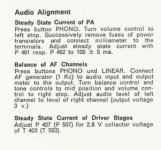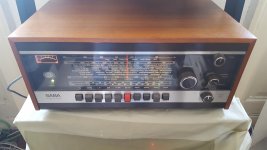Hi there,
I have got a receiver from 1970, a Saba Studio IIa, it features all germanium transistors, so it got a line transformer in front of the output PNP-transistor. and its a nice sounding device.
but i want to modify it more to my taste of playback. and i would really appreciate your thoughts about it.
so far i just replaced or added some elkos at the voltage-stage. and replaced the series C521, because it was faulty.
i would like to deactivate the tone-control. in the ciruit-diagramm, i added a green line for connection and a red for a line-cut, as i would do it right now.
the Receiver got a "Linear"-Switch on the front, if it is not pressed, you get this bathtub-response-curve. - don´t need this either, but its not interfering if not chosen, i guess.
and about the feedback-loop: do i get this right? it just affects transistor AC161 and AC117 trough R542 (680Ohms)? if so, in which range would it be save to vary the value of R542?
and finally: anything you would do to improve this amp?
i have the whole service-manual btw.
thank you,
Daniel
I have got a receiver from 1970, a Saba Studio IIa, it features all germanium transistors, so it got a line transformer in front of the output PNP-transistor. and its a nice sounding device.
but i want to modify it more to my taste of playback. and i would really appreciate your thoughts about it.
so far i just replaced or added some elkos at the voltage-stage. and replaced the series C521, because it was faulty.
i would like to deactivate the tone-control. in the ciruit-diagramm, i added a green line for connection and a red for a line-cut, as i would do it right now.
the Receiver got a "Linear"-Switch on the front, if it is not pressed, you get this bathtub-response-curve. - don´t need this either, but its not interfering if not chosen, i guess.
and about the feedback-loop: do i get this right? it just affects transistor AC161 and AC117 trough R542 (680Ohms)? if so, in which range would it be save to vary the value of R542?
and finally: anything you would do to improve this amp?
i have the whole service-manual btw.
thank you,
Daniel
Attachments
Improve, make more quiet power supply 🙂 Have a nice day
yes, i should probably make a regulator for the voltage-amp.
thanks, have a nice day too..
Weird. I don't get that schematics at all. But I'm quite sure that R542 doesn't serve as GNFB, 'cause in conjunction with C531 it forms a LFP filter with a 0.5 Hz roll-off. OTOH, due to the galvanically isolating phase splitter transformer, it also can't help to stabilize the power devices' operating points. I'm completely off here 😕.
Be careful of these AD166's, btw. Surely they're among the most brittle power transistors I've ever seen. In my youth a friend of mine gave to me a similar device for repair that had four blown AD166's - due to open load operation by accident!! Well, in the 1970ies we could easily replace them with new ones that we ordered from stock, but nowadays??
Best regards!
Be careful of these AD166's, btw. Surely they're among the most brittle power transistors I've ever seen. In my youth a friend of mine gave to me a similar device for repair that had four blown AD166's - due to open load operation by accident!! Well, in the 1970ies we could easily replace them with new ones that we ordered from stock, but nowadays??
Best regards!
Weird. I don't get that schematics at all. But I'm quite sure that R542 doesn't serve as GNFB, 'cause in conjunction with C531 it forms a LFP filter with a 0.5 Hz roll-off. OTOH, due to the galvanically isolating phase splitter transformer, it also can't help to stabilize the power devices' operating points. I'm completely off here 😕.
Be careful of these AD166's, btw. Surely they're among the most brittle power transistors I've ever seen. In my youth a friend of mine gave to me a similar device for repair that had four blown AD166's - due to open load operation by accident!! Well, in the 1970ies we could easily replace them with new ones that we ordered from stock, but nowadays??
Best regards!
thank you!
about the AD166: i already raised their quiescent-current to a level where they get much warmer, not too hot (impreoves the sound to my ears). -do you thing they are in danger?
best regards
Generally speaking: Be careful with germanium power transistors! They by far don't tolerate temperatures as high as silicons.
I don't know the AD166 power dissipation ratings, and I also don't know neither the rail voltages nor the idle current nor the heatsinks' thermal resistances, but I'd feel much safer with the original settings.
Best regards!
I don't know the AD166 power dissipation ratings, and I also don't know neither the rail voltages nor the idle current nor the heatsinks' thermal resistances, but I'd feel much safer with the original settings.
Best regards!
Ah, everyone's favorite, wacky old germanium circuits. Sorry, not at this time of day.
C419, 429, 428 and whatever filter cap comes before that would probably appreciate their retirement at this point; I can't imagine they're much good after 50 years. C419 should be just a regular electrolytic with lowish leakage current, maybe Panasonic FM or FC. Ultralow ESR caps have high leakage currents and are correspondingly noisy.
These classic RC filtered arrangements are very low noise indeed; your main enemy is hum. If you want to add a capacitance multiplier "ripple eater" (like a regulator, just floating), I'd want to use it in the place of R436.
C419, 429, 428 and whatever filter cap comes before that would probably appreciate their retirement at this point; I can't imagine they're much good after 50 years. C419 should be just a regular electrolytic with lowish leakage current, maybe Panasonic FM or FC. Ultralow ESR caps have high leakage currents and are correspondingly noisy.
These classic RC filtered arrangements are very low noise indeed; your main enemy is hum. If you want to add a capacitance multiplier "ripple eater" (like a regulator, just floating), I'd want to use it in the place of R436.
Ah, everyone's favorite, wacky old germanium circuits. Sorry, not at this time of day.
C419, 429, 428 and whatever filter cap comes before that would probably appreciate their retirement at this point; I can't imagine they're much good after 50 years. C419 should be just a regular electrolytic with lowish leakage current, maybe Panasonic FM or FC. Ultralow ESR caps have high leakage currents and are correspondingly noisy.
These classic RC filtered arrangements are very low noise indeed; your main enemy is hum. If you want to add a capacitance multiplier "ripple eater" (like a regulator, just floating), I'd want to use it in the place of R436.
thank you!
well, you know, it must have been a 1000DM-buy back then, i like the sound and 20W are enough for me, so i want to use it as my 2nd device.
i have already replaced those caps, i had some nichicon FG left, they sound allright to me. additionally i added some nichicon BP direct to the transistors. -sounds to clean and bright for me, i will get rid of those..
one thing about the current-amp-caps: those are the original 5000uF-Caps (huge for their little capacity). i tried to add several types, and it never sounded as good, as with just those, so i left them. (pic)
thanks, i will add a capacitance multiplier next (with some IrfP...).
so far i just put a diode in this place, preventing ths current-amp from sucking power from the voltage-amp..
best regards
Last edited:
Yes, most probably you're right with your 1000 DM guess. Check www.radiomuseum.org for that. SABA was a well reputed German manufacturer in those days.
If I get you right, you want to remove any components that introduce linear distortions. So you'd first disconnect anything from the volume control taps and remove the treble control with it's periphery. The bass control is somewhat more tricky: If you do it the way you've drawn, you'd also remove the NFB and the attenuation caused by the control itself. It might be better to leave R526 and R528, shunt R527 and remove the control and both capacitors.
The drawback is that you might not like the device's sound any more. Remember those good old valve based table radios in their huge enclosures. They only sound amazingly due to their frequency dependant feedback loops.
Best regards!
If I get you right, you want to remove any components that introduce linear distortions. So you'd first disconnect anything from the volume control taps and remove the treble control with it's periphery. The bass control is somewhat more tricky: If you do it the way you've drawn, you'd also remove the NFB and the attenuation caused by the control itself. It might be better to leave R526 and R528, shunt R527 and remove the control and both capacitors.
The drawback is that you might not like the device's sound any more. Remember those good old valve based table radios in their huge enclosures. They only sound amazingly due to their frequency dependant feedback loops.
Best regards!
Yes, most probably you're right with your 1000 DM guess. Check www.radiomuseum.org for that. SABA was a well reputed German manufacturer in those days.
If I get you right, you want to remove any components that introduce linear distortions. So you'd first disconnect anything from the volume control taps and remove the treble control with it's periphery. The bass control is somewhat more tricky: If you do it the way you've drawn, you'd also remove the NFB and the attenuation caused by the control itself. It might be better to leave R526 and R528, shunt R527 and remove the control and both capacitors.
The drawback is that you might not like the device's sound any more. Remember those good old valve based table radios in their huge enclosures. They only sound amazingly due to their frequency dependant feedback loops.
Best regards!
thank you! i can work with that. (by shunt you mean to bypass with a small value? plz let me know if i am wrong here)
reducing NFB would be done by increasing R529?
i guess i understand what you mean concerning altering the sound. actually i love the sound of some of these old radios (Minerva etc). and the Saba already sounds a bit too clean, too modern for me (like push and pull often do), even though its a tube-like sound. but some more linear harmonics would be welcome.. -so that would not bee the way to got then.. -anyway, maby i ll give it a try.
it´s still amazing what this amp can do with a good front-end (buffalo III with line-transfomers). -i like the idea of old meets new.
Sorry, I was overlooking your question im my previous posting 🙄.reducing NFB would be done by increasing R529?
Yes, I'd expect that this would be the case. But again, I don't know if you will like the outcome. Try!
Best regards!
- Home
- Amplifiers
- Solid State
- Saba Studio IIa (1970)


